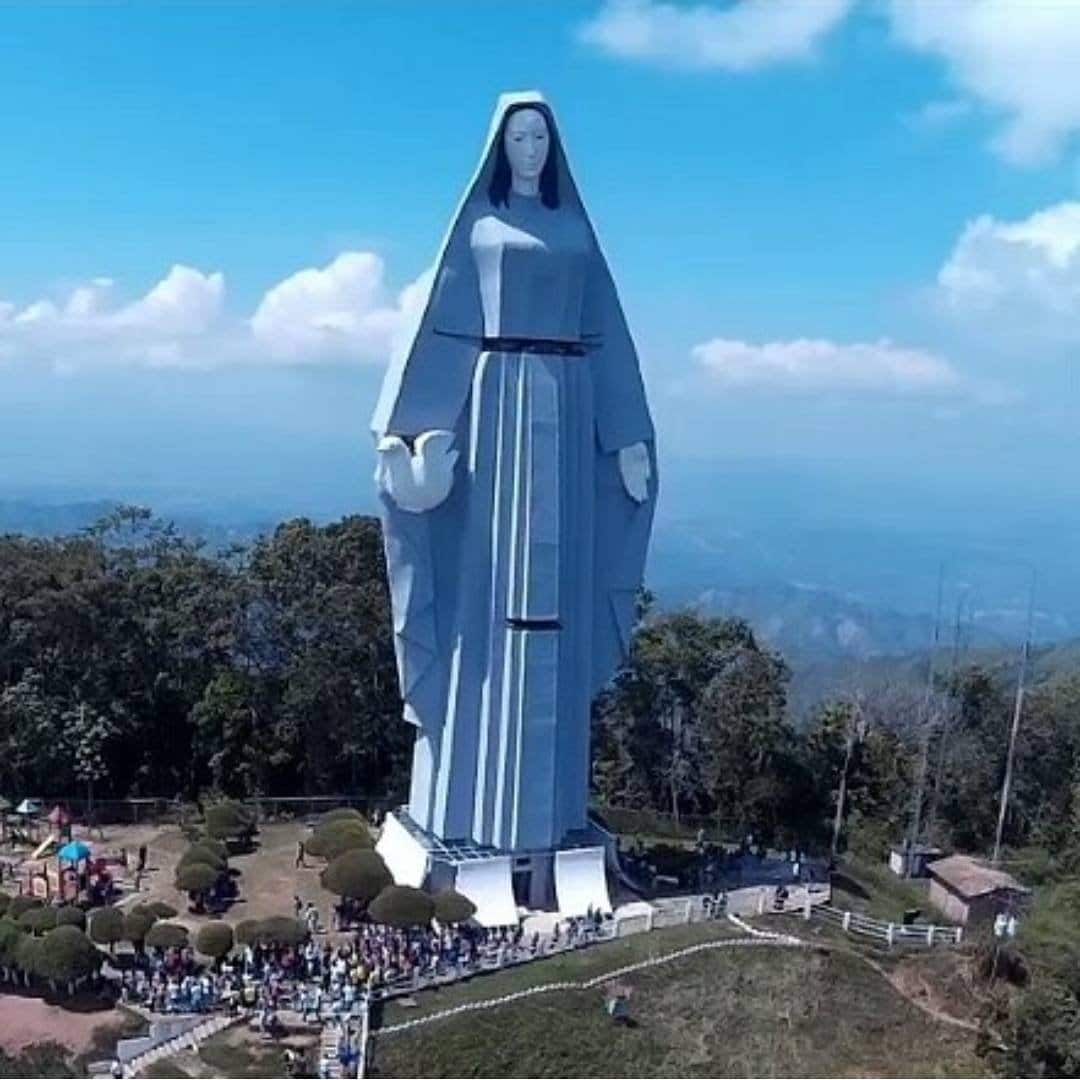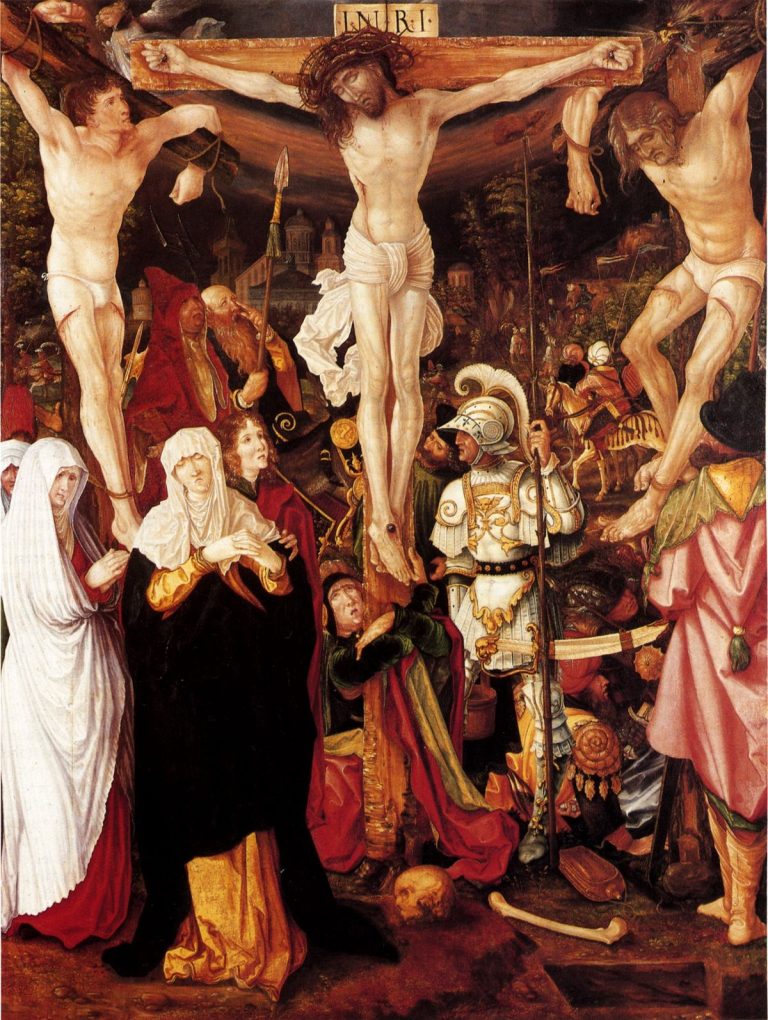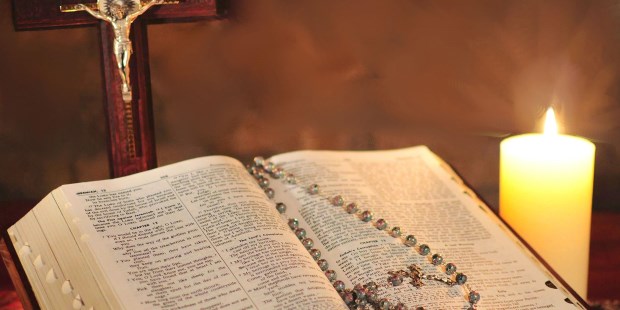The Virgin of Peace, monument in Trujillo (Venezuela)
If you are visiting Trujillo, be sure to visit the fascinating monument to the Virgen de la Paz . Which is considered a commemorative sculpture to Mary, this sculpture is made entirely of pure concrete. This moment is one of the most touristic places in Trujillo in this post we bring you everything you want to know.
Virgin of Peace
Our Lady of Peace or as the Virgin of Peace is popularly known, since 1568 she is the patron saint of each and every one of the Trujillanos, it should also be noted that for the year 1960 she is named as the patron saint of the diocese. The great devotion to this Virgin begins in a place known as Peña de la Virgen, in that place the Virgin appears to several locals who lived in a town known as Carmona.
The Marian devotion to the Virgin of Peace is very extensive, said Virgin has a great monument point that we will address later, in this monument thousands of men and women who are his faithful believers come to him to pay promises for favors received, praise him , thank her, venerate her and bless her through rosaries, chants of salves or hymns of adoration towards her, also the faithful usually return the favors received by placing altars and offerings in the monument or in chapels.
The patron saint of Trujillo has special days in which patron saint festivities are declared throughout the city, these festivities run from January 25 to 30, respectively. In the organization of these patron saint festivities we find both religious and popular activities, in which thousands of faithful believers attend with all devotion to glorify and celebrate our Lady of Peace.
Prayer to the Virgin of Peace
Our Lady and Mother, Holy Virgin Mary, Queen of Peace, Protector of our Diocesan Church:We come to you to beg you for peace.The Peace that the world seeks without finding.The Peace that your Son Jesus Christ came to bring us.The Peace whose only true source is Christ Jesus.We pray that you intercede for us so that we open ourselves to the peace that comes from God.The peace that is the fruit of justice; that has as its soul the love of God and neighbor.Peace that demands that man renounce envy and ambition, pride and selfishness.We come to you so that the peace that God offers us in Jesus, we receive it, preserve it and take it to the world.Help us to be architects of Peace.May your maternal help make us brave, patient and effective in committing ourselves to work for justice, the foundation of the peace that we all need.Our Lady of Peace, pray for us. Amen
History of the Virgin of Peace
The beginnings of the history of the Virgen de la Paz date back to the cathedral of Maestro Santiago de Nuestra Señora de la Paz, said cathedral was closed in 1662. In it, the image of the Virgen de la Paz was gilded and greatly venerated. Since the beginning of the 17th century, his image was used as a symbol of peace for all cities and states. It should be noted that on March 1, 1821, through the interception of the miraculous Virgin of Peace, Bishop Lasso de la Vega respected the liberator of their lands as Ruler of the same.
The origins of the image of the Virgen de la Paz, has its starting point in the seventh century. In the history of this virgin, a bishop from Toledo Spain called San Ildefonso de Toledo (606-667), who was supervisor of the diocese of Toledo, is involved at this time, he was well known throughout Spain for his great devotion to the Virgen de la Paz and his great commitment to the Marian devotion to the Virgin that existed at the time in which he was part of this distinguished Spanish temple.
According to what is known, Ildefonso entered the cathedral of Santa María de Toledo on a December night and was totally impressed with the beauty of this characteristic cathedral and its great lighting. Said bishop indicated that when he entered the cathedral, stunned by its beauty, he was able to observe a great glow inside the chapel and the Virgin seated in the chair of the ecclesiastical supervisor.
This hypothesis was correctly deciphered and was attributed to the lessons and contributions of Ildefonso, for the cathedral of Toledo at that time, unfortunately this bishop one night of January 23.
In this way it is important to highlight that for the year 1805 in the midst of the Muslim invasion of Spain, the cathedral of Santa María de Toledo is attacked by these invaders. Through this invasion the Muslims settled in Toledo-Spain and among their plans they had to convert the construction of this representative cathedral into a Mosque, however, over the years the heads of these invaders came to change their opinion about the plans they had for the cathedral and the Christian sanctuary were fully restored.
This important event occurred specifically on January 24 of the year previously mentioned, the faithful devotees of the Virgin of Peace credit her with the miracle that the Muslims changed their minds about the plans they had with the sanctuary and ensured that she in all At that time he sought to protect the Christian faith and the temple where all his faithful attended to pray to him and venerate him tirelessly.
The place where the great monument to Peace is located at that time was inhabited by the aboriginal society that was known as the Eskuke, a territory in which an indigenous uprising took place, it is presumed, and which was directed at the time by the Cacique Pitijoc. From what is known about the Chibchano-Paezano hypotheses, they had the same root as the Colombian Chibchas and Muiskas.
And they were the ones who fought against the Spanish pilgrims, resulting in the defeat of the indigenous people. On November 9, 1557, Trujillo was established and later the monument to the Virgen de la Paz was built, after having won the veneration and trust of all, this as a substitute for the monument of the indigenous goddess.
Legend
According to legend, both the name given to the monument and its appearance refer to the hill where it was seen for the first time, which is known as Peña de la virgen. The legend of the Virgen de la Paz refers to the fact that, towards the end of the year 1550, the image of the Virgen de la Paz was seen for the first time by several inhabitants of the town called Carmona.
Therefore, the locals were able to observe it was a young woman with very delicate and characteristic fractions and a great spirit who was buying a few candles for her fire, the young woman enters an establishment and a couple of men who were inside ask her what Next; “Why is she walking alone?” and she would answer them: “not alone, but with God, the sun and the stars”.
According to other hypotheses, it is indicated that the woman responded to the men; “Children, do not forget that I walk with God, my protector.”
The men, stunned by such a response that the young woman gave them, decide to leave the establishment at the same time as her and without realizing it, they follow her steps and realize that the young woman is going to the hill called Peña, the men continued following her steps. steps and observed how the young woman was hiding inside some stones and they witnessed some beautiful flashes of light that stand out from the stones where the young woman has just entered.
At that moment the men realized that it was not a simple mortal with whom they had just exchanged a few simple words and they saw her enter between the stones, but that it was the Blessed Virgin Mary.
For December of the year 1983, in honor of the great devotion that they had for such a characteristic Virgin, they inaugurated the monument to the Virgen de la Paz. Said monument was designed by the great sculptor Manuel de la Fuente and the calculations were carried out by the engineer Camargo. The monument has 5 viewpoints respectively from which you can clearly see the Trujillo state, as well as part of the Sierra Nevada de Mérida and the South Coast of Lake Maracaibo.
In the next point we will describe in more detail such an important monument dedicated to the Virgen de la Paz and that is located in Trujillo, continue reading.
Monument to the Virgin
The monument of the virgin of peace Better known as the monument to Peace, it is located in the City of Trujillo specifically on the highest peak that can be seen in the city, This monument is visited by thousands of men and women, that is to say, it has a large number of visitors and that is why this monument is considered the most visited tourist place in the entire state.
The construction of this monument arises from the idea of the first lady of Venezuela at the time, Mrs. Betty Urdaneta de Herrera Campins, who was Trujillana and was Governor of the state, the Virgin of Peace was proclaimed patron saint of each and every one of the Trujillonos since the 16th century. The construction of this monument lasted approximately 18 months respectively and was officially inaugurated on December 21, 1983, the year of the birth of our liberator Simón Bolívar.
The monument opens its doors and is inaugurated on the date mentioned above, under the liturgical blessing of the newly ordained Cardinal José Alí Lebrún Moratinos. In the sculpture you can see the Virgin wearing a blue tunic, as previously mentioned this sculpture was designed by the sculptor Manuel de la Fuente and the engineer Rosendo Camargo, they also had the collaboration of the priest Juan Francisco Hernández.
This sculpture was made on a steel structure to make the entire skeleton of the work, to later be poured with pure concrete.
The sculpture has a weight of 1,200 tons and a height of 46.72 meters by 16 meters wide, the head of the sculpture alone weighs approximately 8 tons. The total cost of this monument at the time its elaboration was completed yielded an amount of 9,000,000 Venezuelan bolivars.
As mentioned in previous lines, this sculpture is composed of 46.72 meters high and 16 meters wide, the monument to the Virgin of Peace is the tallest sculpture in America among all of its kind. The Christ the Redeemer that is located on the top of the Corcovado hill in Rio de Janeiro, has a height of 38 meters high including its base, for its part the statue of liberty is composed of 46.05 meters high.
At the top of his torch, but it looks taller for being mounted on a huge pedestal 46.94 meters high.
It has already been mentioned that the monument is located in the city of Trujillo, specifically to the southwest of the city and on the top of the hill called La Peña a la Virgen de la Paz, where the entire legend of the Virgen de la Paz begins in the year 1550 respectively, this sculpture to peace has a height of 1,640 meters above sea level, and as is known it was inaugurated in December 1983 after a few long months of arduous and complicated work.
But the goal was achieved, the sanctuary where thousands of men and women come to venerate, adore and glorify our entire Virgin of Peace, patron saint of all Trujillanos for many years.
The Peace Monument is a symbol of Trujillo pride, so if you are visiting this state, do not forget to visit such a characteristic monument, you will reach it, it is not complicated at all and if for some reason you cannot find the address, do not worry. that, if you ask any native of the City, they will kindly guide you and show you how to get safely to the monument without any loss again.
The monument to the Virgen de la Paz is open to the public every day, at the following times; from 9:00 a.m. to 5:00 p.m., however, it is important to note that they only allow tourists who wish to climb the monument to enter until 4:30 p.m.
In order to go up to the monument, a ticket must be purchased that must be presented at the door when entering, adults pay a totally different amount than adults, however, for the date they do not take into account what is the amount that currently it is canceled by the ticket that must be obtained to proceed to enter and climb the peace monument.
Once you enter the monument, there is nothing left to do but climb the stairs of said sculpture to enjoy the view and thus be able to appreciate the different viewpoints by which the sculpture is composed.
At the beginning of the tour of the sculpture, if we reach the knees, it is about 18 meters high respectively, if we reach the left hand we are about 22 meters high, if we continue climbing and we reach the right hand; which is the hand where the virgin holds the dove of Peace, it can be said that we are about 26 meters high.
Continuing with the tour of the sculpture and reaching the waist we are at 30 meters high, when we reach the eyes, which is practically the end of the sculpture, we are at 44 meters high respectively. It is important to highlight that the sculpture has an elevator; for elderly people and people with disabilities who visit the sanctuary and it is difficult for them due to their condition to climb all the stairs until they reach the full height of the monument.
The sculpture is respectively composed of 5 viewpoints which are strategically located along or across the entire sculpture, so that tourists who enter the monument from the point where they are located can observe from various directions. Each and every one of these viewpoints can be entered through the internal stairs of the monument, or through the elevators arranged in the monument.
If we go up to the sculpture when the weather is completely clear, we can almost see the Trujillo state in its entirety, as well as a small part of the Sierra Nevada of the Mérida State and the southern coast of Lake Maracaibo, respectively. .
It is important to mention that right next to the monument to the Virgen de la Paz, a small chapel is located that has a characteristic dome shape, and in this way it can be delimited that its dome is decorated by a very beautiful and colorful stained glass window. , and that through it it is possible to observe a resplendent dove that illusions a great spiritual radiance and whose dove specifically symbolizes peace.
Although in life Pope John Paul II never got to visit the state of Trujillo and much less did he manage to visit the monument to peace, thanks to the great dedication and devotion that this monument has, over the years he had the presence of the ambassador of Venezuela before the Holy See. The ambassador at the time was Mr. Luciano Noguera Mora and his visit was accompanied by a televised message from Pope John Paul II and it was broadcast throughout the Venezuelan Catholic community.
The Trujillano Mario Briceño Perozo, gave a beautiful speech during the dedication ceremony to the monument, and when referring to what is the tradition of climbing to the Peña de la Virgen, he said:
“The surroundings of the rock offered exuberant vegetation. The dew-soaked coffee plantations under the protection of tall bucares crowned with wild purple. And on both sides of the mossy path, the ferns, the storax and the pascuitas that will come down to the city to perfume the homemade manger.”
Worship
With this imposing monument to peace it is absolutely demonstrated that it is capable of generating a discursive synergy between the nature-statement and the religious-statement, capable of taking the observer to a special state of perception of the sacred.
As mentioned in previous lines of the section, between January 24 and 30 in the state of Trujillo, the patron saint festivities are celebrated in honor of the Virgen de la Paz, if throughout the year the monument receives the most visits as a tourist spot. of the area, during the patron saint festivities it can be said that the visit of tourists and parishioners increases much more, the activities that predominate during these festivities are; masses and processions in honor of the virgin of peace.
You can see great gastronomic fairs with typical foods from both the state and all of Venezuela, cultural and recreational fairs which spread to La Plazuela and Isnotú.
Thousands of men and women each week go to the hill named Peña de la Virgen as a meeting point to pray together with the prayer and recollection center and in this way each one of those present there enters in prayer, to ask for their loved ones and friends. They ask for her health, her protection and for our mother Mary to keep away from all of us any evil that may come our way.
In this way, many of the believers who also attend this ceremony, so to speak, do so as a way to pay some promise to the Virgin, to sing salves in gratitude for the favors received or to repay some favor received also through an offering. It is customary that every year in each Holy Week in the first hour of the morning the ceremony begins from the headquarters of the Catholic Seminary of the city of Trujillo and then culminates with a mass in the chapel of the monument.
viewpoints
As has already been mentioned throughout the section on the monument, it is made up of 5 viewpoints respectively, which are entered from inside the statue of the Virgin. Four of the viewpoints are located towards each of the cardinal points and the fifth and last viewpoint is located exactly in the eyes of the virgin, however, this one that was mentioned last is the least visited by tourists since due to its great height and the feeling of vertigo that people can feel prefer to stay in the other four viewpoints.
The first viewpoint is located exactly at the knees of the virgin and is about 18 meters high respectively, to reach this viewpoint it can be done by stairs or by means of the elevator, and from it you can see the city of Trujillo, capital of the homonymous state.
The second viewpoint is located on the left hand side of the Virgin and is approximately 22 meters high respectively. From that viewpoint it is possible to clearly see the city of Trujillo and all its surroundings, it can also be observed; the Monay plains, the Agua Viva reservoir, Betijoque, Motatán, as well as the agricultural fields of Isnotú and the Pampanito municipality. To get to this viewpoint it can only be done by stairs.
For its part, the third viewpoint is located on the right hand, the hand where the Virgin holds the Dove that symbolizes peace, this viewpoint is 26 meters high. And from there you can see Niquitao’s tit
The fourth Mirador is located at the waist of the Virgin and is 30 meters high, from here you can clearly see the eastern shore of Lake Maracaibo, La Ceiba. As well as we can see several moors, the crests of the Sierra Nevada de Mérida and part of the Trujillana until the Lara State.
Last but not least, we can name the fifth viewpoint, which is the highest and is 44 meters high and is located in the eyes of the Virgin. To get to this viewpoint it can only be done by means of the stairs.
Location of the monument
The monument, as we already know, is located in Trujillo, but specifically it is located between the valley of the cedars Cedros and the Zanjón de Los Mucas, that is to say, it is exactly about 565 km from Caracas. On the other hand, if you go from Maracaibo, you must first pass through the city of Valera and to enter the monument you must take the Valera – Trujillo highway.
If you go to the north, you must first pass through Pampán and Pampanito, and then enter the previously mentioned highway. If, on the other hand, you go from Boconó to Trujillo, to make it more comfortable, you can take the road that leaves Siquisay and reaches La Plazuela. All the roads are very well paved, although in some sections it can be quite narrow.

Hello! Let me enthusiastically introduce myself as a dedicated blogger fueled by an intense passion for meticulously crafting insightful and well-researched blogs. My mission revolves around providing you, dear readers, with a veritable treasure trove of invaluable information.







